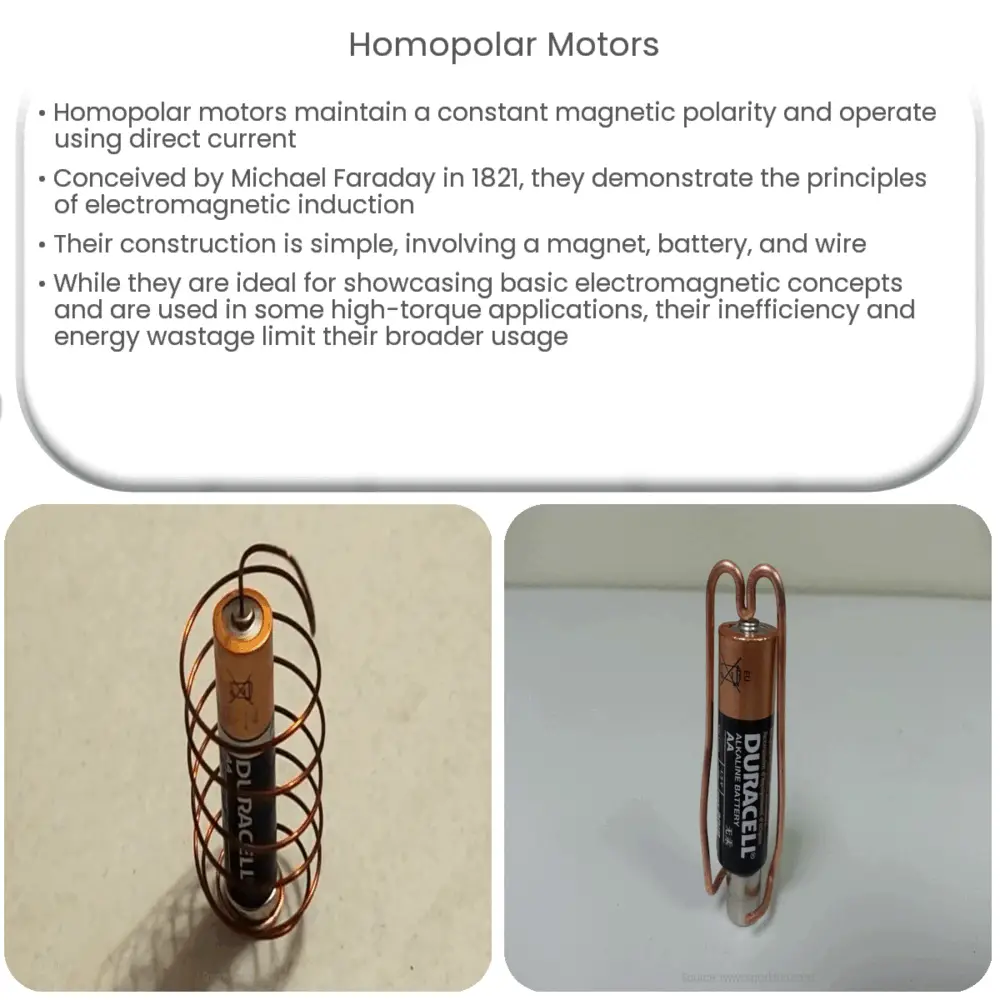Explore the world of homopolar motors, from their history and construction to their working principles, advantages, disadvantages, and applications.

Understanding Homopolar Motors
The term homopolar refers to a system where the polarity does not change. Hence, a homopolar motor, one of the simplest types of electric motor, operates by using a direct current (DC) and maintaining a constant magnetic polarity.
The principle of operation for homopolar motors hinges upon the fundamental concepts of electromagnetic induction. According to Faraday’s law of electromagnetic induction, when a conductor moves through a magnetic field, an electric current is induced within the conductor.
History of Homopolar Motors
The history of homopolar motors dates back to the 19th century. The initial concept of a homopolar motor was conceived and developed by the celebrated scientist Michael Faraday in 1821. Faraday’s experiment consisted of a simple setup involving a battery, a magnet, and a wire, which was the precursor to the modern homopolar motor.
Construction of a Homopolar Motor
The basic construction of a homopolar motor involves very few components. A strong magnet, a battery and a piece of wire are the primary elements required to construct a simple homopolar motor. The magnet, typically a neodymium magnet due to its high magnetic field strength, is connected to one pole of the battery while the wire is connected to the other.
- Magnet: This serves as the source of the magnetic field. The strength of the magnet directly impacts the operation of the motor. In most instances, neodymium magnets are employed due to their high field strength.
- Battery: The battery serves as the power source for the motor. It provides the necessary electric current.
- Wire: This is the conductor through which the electric current flows. The wire is usually bent into a particular shape to aid in the rotation of the motor.
The arrangement of these elements in the correct manner will result in the creation of a rotational force, or torque, causing the wire to spin around the magnet, thereby illustrating the principles of a homopolar motor.
Working Principle of Homopolar Motors
The working principle of a homopolar motor is grounded in the Lorentz force law. When an electric current passes through the conductor (the wire), and that conductor is in a magnetic field, a force is exerted on the conductor. This force, known as the Lorentz force, is what causes the wire to rotate around the magnet.
Advantages and Disadvantages of Homopolar Motors
Homopolar motors, while simple, offer a number of advantages, but also come with their own set of drawbacks.
- Advantages: The foremost advantage of a homopolar motor is its simplicity. This makes it a perfect demonstrator for basic principles of electromagnetism and motor operation. Furthermore, they can provide high torque at a low rotational speed, which makes them useful in specific applications, like in certain types of electric vehicles or heavy machinery.
- Disadvantages: The primary disadvantage of homopolar motors is their inefficiency. Due to the single current path, there is considerable energy wastage in the form of heat. Moreover, they often require high current to function, which further limits their application in real-world systems.
Applications of Homopolar Motors
Despite their limitations, homopolar motors find usage in several practical applications. They are typically used in situations where simplicity and cost-effectiveness are more important than efficiency. For instance, they are used in some types of electric toys and in scientific demonstrations of electromagnetic principles. On a larger scale, there has been research into their use in high torque, low-speed applications, such as in propulsion systems for electric vehicles or heavy machinery.
Conclusion
In summary, the homopolar motor, with its simple construction and clear demonstration of basic electromagnetic principles, plays a critical role in the field of electric motors. Though its inefficiencies limit its widespread application in advanced machinery, it finds its niche in specific low-speed, high torque applications and in educational contexts. Despite being one of the oldest types of electric motors, the homopolar motor still holds relevance today, continuing to spark curiosity and teach us about the fundamental interplay between electricity and magnetism.

